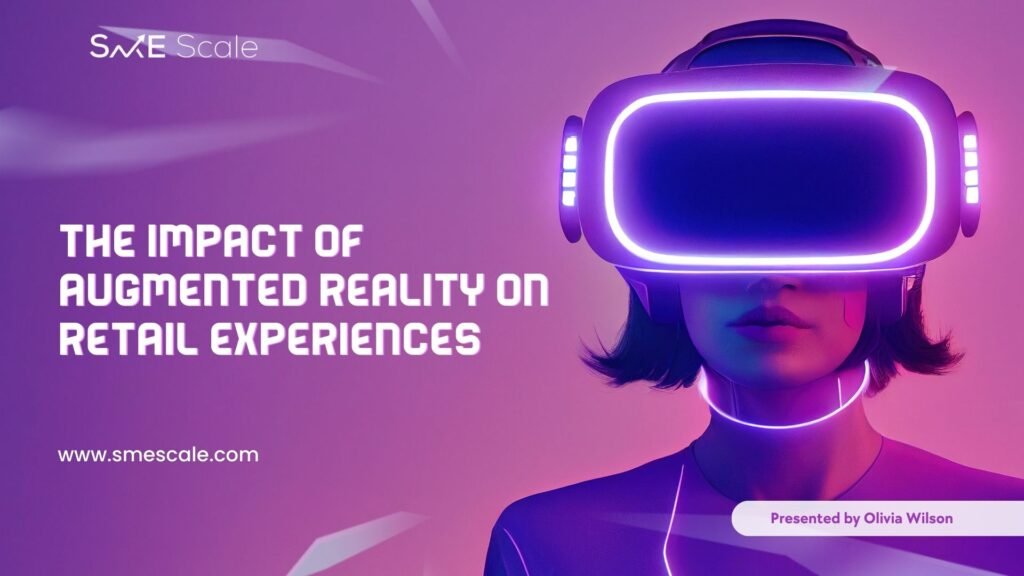The Impact of Augmented Reality on Retail Experiences: A New Frontier for SMEs

In the ever-evolving retail landscape, businesses must continuously innovate to captivate customers and stand out from competitors. Augmented Reality (AR) has emerged as a game-changing technology, transforming how customers interact with products and brands. For small and medium-sized enterprises (SMEs), AR offers an exciting opportunity to enhance retail experiences, drive engagement, and boost sales. This blog explores the impact of AR on retail, delves into the psychology behind its success, and shares a real-life case study where SME Scale helped a business achieve remarkable results.
What is Augmented Reality?
Augmented Reality overlays digital information onto the physical world through devices like smartphones or AR glasses. Unlike virtual reality, which creates entirely digital environments, AR enhances real-world experiences, enabling customers to visualize products, access interactive content, or navigate physical spaces with digital assistance.
How AR is Transforming Retail Experiences
1. Immersive Product Interaction
AR allows customers to visualize products in their real-world environment. For instance, customers can “try on” clothes or makeup virtually or see how furniture fits in their homes.
2. Enhanced Customer Engagement
Interactive AR experiences captivate users, keeping them engaged with the brand longer and fostering stronger emotional connections.
3. Personalized Shopping
AR technology can provide tailored recommendations and experiences based on user preferences, creating a more personalized journey.
4. Seamless Online-to-Offline Integration
AR bridges the gap between online and offline shopping, offering features like in-store navigation or virtual product demonstrations to enhance the physical retail experience.
The Psychology Behind AR’s Retail Success
The Novelty Effect
AR leverages the human fascination with new and innovative technologies. This novelty captures attention and creates memorable shopping experiences.
Reduced Uncertainty
By visualizing products in real-world settings, customers feel more confident in their purchasing decisions, reducing buyer’s remorse and cart abandonment.
Emotional Engagement
AR experiences are interactive and fun, tapping into emotions and fostering positive associations with the brand.
Social Proof
Customers often share AR experiences on social media, creating organic buzz and leveraging the psychological power of peer influence.
Real-Life Case Study: SME Scale and “StyleHome Interiors”
The Challenge
StyleHome Interiors, a boutique furniture retailer, faced challenges in helping customers visualize how products would fit and look in their spaces. The inability to provide this experience online led to high cart abandonment rates and reduced customer satisfaction.
The Solution
Partnering with SME Scale, StyleHome Interiors integrated AR technology into their website and mobile app. Key features included:
Virtual Room Designer: Customers could upload photos of their rooms and use AR to place StyleHome’s furniture in their space.
In-Store AR Kiosks: SME Scale developed interactive kiosks that allowed in-store customers to visualize products in a virtual space.
AR-Powered Marketing Campaign: SME Scale crafted an AR-centric campaign showcasing customers’ creative uses of the technology, encouraging user-generated content.
Results
Increased Sales: Online sales grew by 40% within six months, driven by improved customer confidence.
Enhanced Customer Engagement: Time spent on the website doubled as customers explored the AR features.
Social Media Buzz: The AR campaign generated over 1,000 customer posts, boosting brand visibility and engagement.
Reduced Returns: Product returns decreased by 25%, as customers were better able to gauge suitability before purchasing.
Actionable Steps for SMEs to Leverage AR in Retail
1. Identify Opportunities
Analyze your product offerings and customer journey to determine where AR can add value. Examples include virtual try-ons, product visualization, or in-store navigation.
2. Choose the Right Technology
Work with experts like SME Scale to select and implement AR solutions that align with your goals and budget.
3. Integrate AR with Marketing
Promote your AR features through social media, email campaigns, and in-store promotions to maximize their impact.
4. Educate and Engage Customers
Provide tutorials or demos to help customers understand and use AR features, enhancing adoption rates.
5. Measure and Optimize
Track metrics like engagement, conversion rates, and customer feedback to refine your AR strategy and maximize ROI.
How SME Scale Empowers SMEs with AR Solutions
SME Scale specializes in integrating cutting-edge technologies like AR into business strategies. From initial concept to execution, SME Scale offers:
Customized AR solutions tailored to your business needs.
Marketing campaigns that highlight AR features and drive customer engagement.
Data analytics to measure the impact of AR on sales and customer satisfaction.
By partnering with SME Scale, SMEs can unlock the full potential of AR technology to transform their retail experiences.
Conclusion: AR is the Future of Retail
Augmented Reality is revolutionizing the retail industry, offering SMEs an unprecedented opportunity to innovate and thrive. By enhancing customer experiences, building trust, and driving engagement, AR helps businesses stand out in a competitive market.
As StyleHome Interiors’ journey illustrates, integrating AR with a strategic marketing approach can deliver remarkable results. Ready to explore how AR can elevate your retail business? Contact SME Scale today to begin your transformation.

